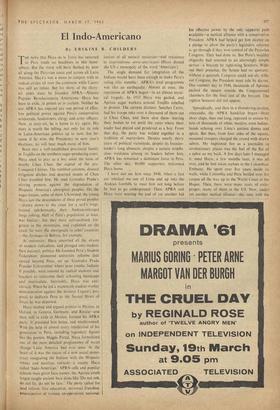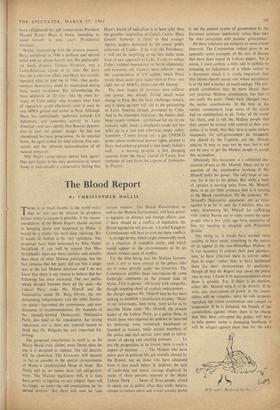El Indo-Americano
.By ERSKINE B. CHILDERS
THE news that Haya de la Torre has returned to Peru made no headlines in this hemi- sphere. But the word will have flashed by now all along the Peruvian coast and across all Latin America. Haya's was a name to conjure with in radical circles all over the continent while Castro was still an infant. But for thirty of the thirty- six years since he founded APRA—Alianza Popular Revolucionaria Americana—Haya has been in exile, in prison or in asylum. Neither he nor APRA has enjoyed any one period of effec- tive political power against Peru's conservative aristocrats, landowners, clergy and army officers. Now, at sixty-six, he is home to try again. His story is worth the telling, not only for its role in Latin-American politics up to now, but be- cause if he wins the Presidency in next year's elections, we will hear much more of him.
Born into a well-established provincial family in Trujillo on the northern sugar-producing coast. Haya used to play as a boy amid the ruins of nearby Chan Chan, the capital of the pre- Conquest Chimus. The tumbled columns, disused irrigation ditches and deserted streets of Chan Chan troubled him. He read Gonzalez Prada's stirring protests against the degradation of Hispanic America's aboriginal peoples. On the sugar estates, some of them US-owned, the young Haya saw the descendants of these proud peoples --drawn down to the coast for a serf's wage, treated sub-humanly, their Andean-enlarged lungs rotting. Half of Peru's population, at least, was Indian: but they were enfranchised, for- gotten in the mountains, and exploited on the coast.' So were the aboriginals in othecountries --the Aymara' in Bolivia, for example.
At university, Haya absorbed all the strains of modern radicalism, and plunged into student. then national, politics. He founded Peru's Student Federation; 'pioneered university reforms that spread beyond Peru; set up 'Gonzalez Nada Popular Universities' where poor youths. Indians it' possible. were tutored by radical students and teachers to overcome their schooling handicaps and matriculate. Inevitably, Hayti was anti- clerical. When he led a mammoth student-worker demonstration against the dictator Leguia's pro- posal to dedicate Peru to the Sacred Heart of Jesus, he was deported.
Elti■ a studied and argued polities in Mexico, at Oxford. in Geneva, Germany. and Russia--and then, still in exile in Mexico, formed his APRA party. It preceded him home, and mushroomed. With the help of almost every intellectual of his generation in Peru, including legendary figures like'the poetess Magda Portal, Haya formulated one of the most detailed programmes of social change Latin America had ever seen. At the heart of it was the vision of a new social demo- cracy integrating the Indians with the Hispanic whites and mestizos Imixed)—a society Haya called 'Indo-American.' APRA cells and popidar schools were given Inca names; the Aprista youth league taught ancient Inca dicta like `Do not rob, do not lie, do not be lazy.' The party called for land reform, free education, universal franchise, emancipation of women, co-operatives, national- isation of all natural resources—and resistance to imperialism° rzorte-americano (Haya denied the US a monopoly of the word 'American').
The single demand for integration of the Indians would have been enough to make Peru's ruling dire tremble: APRA's total programme was like an earthquake. Almost at once, the repression of APRA began—in an almost mysti- cal tragedy. In 1933 Haya was gaoled, and Aprista sugar • workers around Trujillo rebelled in protest. The current dictator, Sanchez Cerro, had his troops take over a thousand of them out to Chan Chan, and there shot them—leaving their bodies to rot amid the ruins where their leader had played and pondered as a boy. From that day, the party was welded together in a tradition of martyrdom. Despite nearly thirty years of political vicissitude, despite its founder- leader's long absences, despite a certain middle- class weakness among its leaders below him, APRA has remained a dominant force in Peru. The other day, 80,000 supporters welcomed Hayti home.
I have not see him since 1948, when a fast car whisked me out of Lima and up into the Andean foothills to meet him not long before he had to go underground. Then, APRA and Haya were nearing the end of yet another bid for effective power by the only 'apparent path available—a tactical alliance with a conservative President. APRA had helped get him elected on a pledge to allow the party's legislative reforms go through if they won control of the Peruvian Congress. They had done so. But Peru's wealthy oligarchy had resorted to an alarmingly simple device--a boycott by right-wing Senators. With- out their presence, the Senate had no quorum; Without a quorum, Congress could not sit; with- out Congress. the President must rule by decree. One summer day in 1948, thousands of Apristas packed the square outside the Congressional chambers for the final test of the boycott. The rightist Senators did not appear.
Sporadically, and then in a thundering protest, crescendo, the APRA handclap began—three short claps, then one long, repeated in unison by tens of thousands of white, mestizo, even Indian, hands echoing over Lima's ancient domes and spires. But then, from four sides of the square, mounted troopers charged the crowd with drawn sabres. My baptismal fire as a journalist in revolutionary places was the feel of the flat of a sabre on my back. A few days later I managed ti meet Haya; a few months later, it was all over, and ,he had taken asylum in the Colombian Embassy. He spent over five years inside its walls, while Colombia and Peru battled over his corpus all the way up to the World Court at the Hague. Then, there were more years of exile- proper, many of them in the US. Now, under yet another tactical alliance- this time with the
more enlightened but still conservative President Manuel Prado--Haya is home, intending to stand himself in next. year's Presidential elections.
Stocky, unassuming with the poorest peasant. Haya combined in 1948 a brilliant and shrewd mind with an almost boyish zest. His philosophi- cal bock. E■pario Tiempo Historic°, was a Latin-American classic of its time. His party was not a one-man affair, and Haya has recently repeated what he told me in 1948—that parlia- mentary democracy could be maintained during basic social revolution. But remembering the mass adulation of 'El Jefe'—like the mass fer- vency of Cuba today—one wonderS what kind of opposition could effectively exist if once he and APRA gained real power in Peru. Although Haya has undoubtedly mellowed towards US diplomatic and economic activity in Latin America—and says openly that Russian penetra- tion is now the greater danger--he has not abandoned his basic programme. As he returned home, he again called for land reform, free edu- cation, and the ultimate nationalisation of all natural resources.
Will Peru's conservatives defeat him again? One new factor in his very permission to return home is undoubtedly a conservative feeling that Maya's brand of radicalism is at least safer than the grassfire inspiration of Cuba's Castro. Haya himself, however, is likely to find younger Aprista leaders distressed by his recent public criticisms of Castro: if he wins the Presidency, it will not be surprising to see him make some kind of new approach to Cuba. if only to reduce Cuba's isolated dependence on Soviet diplomatic and economic aid. Castro's basic reforms—save the expropriation of US capital, which Haya would place under joint supervision in Peru---are right out of APRA's thirty-,■ear-old manual.
The sheer impact of A primer, even without real power. has already forced much social change in Peru. But the basic challenges remain, and if taken up now will add to the galvanising of Latin America already prompted by Cuba. And in the mountain fastnesses. the Indian chal- lenge largely remains- -symbolised for me in one fantastic sight inside a shepherd's crude but two miles tip in a vast and other++ ise empty valley. Somehow-1 never found out a gay UNESCO poster about multiracial human rights, printed in Paris. had ended up pinned to that lonely Indian's wall . . . a moving promise. a few plunging canyons from the Incas' capital of Cuzco, four centuries of time from the capture of Atahualpa by Piiarrci.







































 Previous page
Previous page